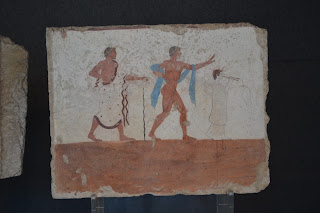February 24 and 25 our class embarked on what has been deemed "The South Field trip". This two-day class field trip features included the archaeological sites of Pompeii and Paestum. The first stop was Pompeii, which is located just southeast of modern day Naples near the looming volcano of Mount Vesuvius.
Until 1749, when it was first discovered, the city of Pompeii was buried in up to 20 feet of volcanic ash and pumice from an eruption of the volcano in 79 AD. The eruption buried the town and many of its residents, making it a time capsule of the Roman life. Through the years, the city has slowly been uncovered, and offers a wonderful (and sometimes eerie) step back in time.
 |
| Porta Marina, one of the gates of Pompeii |
 |
Looking across the walls of Pompeii,
the gate to the city is in the upper right |
 |
| Mount Vesuvius in the background |
 |
the basilica of Pompeii
(in Roman times a basilica was a public meeting hall, not a place of worship) |
 |
| Walking the streets of Pompeii |
 |
| Ancient Roman bar! |
 |
Another type of bar. This one was used to store pre-made food.
The original fast food! |
 |
| Porta Nuceria |
 |
Romans buried their dead outside of the city walls,
therefore the road's leading to cities often had tombs all along them |
 |
| The archway under the Amphitheatre |
 |
| Inside the Amphitheatre |
 |
| Outside view of the Amphitheatre |
 |
| Colonnade lining a courtyard |
 |
All along the streets you can see the indent from the wheels of carriages and carts.
The taller stones on either side were pedestrian stepping stones,
because the streets were often filled with waste. |
 |
The faun statue in the center of the impluvium.
The house it was found in has since been called the House of the Faun. |
 |
Mosaic in the House of the Faun depicting Alexander the
Great at the Battle of Issus against the Persians |
 |
| Colonnade at the House of the Faun |
 |
| Detail picture at the House of the Faun |
 |
| Another roadside tomb |
 |
| Arches along the road, outside the city |
 |
| The flowers were starting to bloom! |
 |
During excavation voids were found in the debris.
When archaeologists filled them with plaster,
the human forms of those who died in the disaster were revealed. |
 |
Just outside of the city was a farm house that is now called
the Villa dei Misteri, or the house of mysteries. |
 |
| Outside of the Villa dei Misteri |
 |
| The looking across the forum to the markets |
 |
| Looking across the theater and part of the ancient city |
 |
| The forum and the Temple of Jupiter |
 |
| One last look across the city |























































